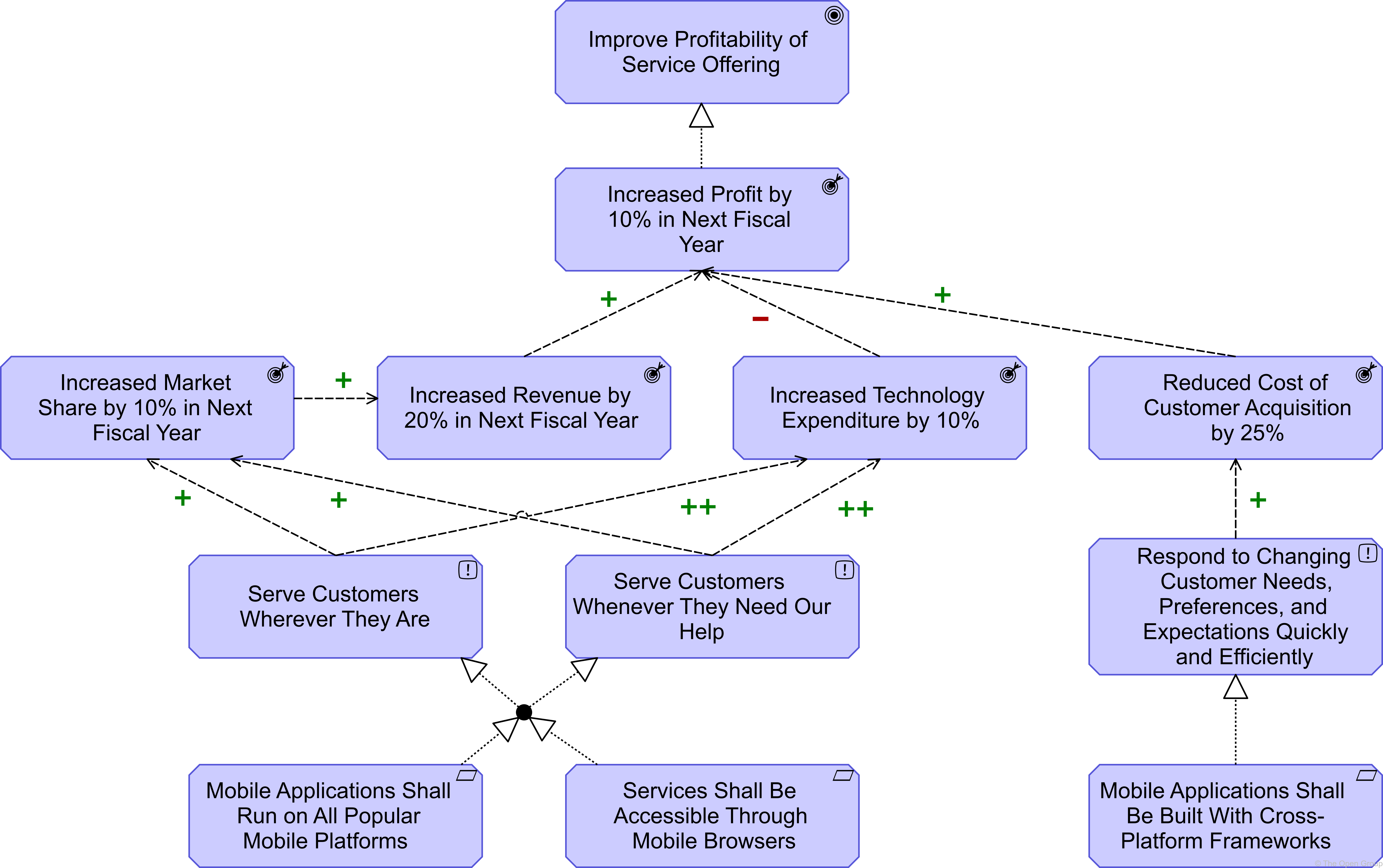Navigating Enterprise Architecture: Deciphering the ArchiMate Motivation View
In the intricate world of enterprise architecture (EA), understanding the motivation behind change is crucial. The ArchiMate Motivation View, also known as the Goals View, allows us to explore the WHY, WHOM, and WHAT of demand. Let’s delve into this powerful viewpoint and discover how it sheds light on the driving forces behind architectural decisions.
1. What Is the Motivation View?
- The Motivation View captures the reasons and drivers that guide changes in an enterprise architecture.
- It answers fundamental questions:
- WHY is this change needed?
- WHOM does it impact?
- WHAT are the goals and outcomes?
- When appropriate, it can also associate a Value to illustrate the concrete benefits of the demand.
2. Elements in the Motivation View:
-
Stakeholder:
- A stakeholder represents an individual, team, or organization with interests in the effects of the architecture.
- Stakeholders have concerns or interests related to the organization and its enterprise architecture.
- Examples include the Chief Executive Officer (CEO), board of directors, shareholders, customers, and legislative authorities.
-
Driver:
- A driver represents an external or internal condition motivating an organization to define goals and implement necessary changes.
- Drivers that are associated with a stakeholder are often called “concerns” of that stakeholder.
- Examples of internal drivers are customer satisfaction and profitability.
-
Assessment:
- An assessment evaluates drivers and concerns.
- Techniques like SWOT analysis help enterprises respond effectively.
-
Goal:
- A goal describes a desired outcome.
- Stakeholders set and emphasize goals to direct efforts.
- Example: Increasing customer satisfaction by 10%.
-
Outcome:
- An outcome represents the actual result achieved.
- It reflects the impact of architecture changes on goals.
-
Principle:
- A principle guides decision-making.
- It represents a desired property of solutions to realize goals.
-
Requirement:
- A requirement specifies necessary conditions.
- It ensures that solutions align with goals.
- Requirements can have subtypes, such as constraint.
-
Constraint:
- A constraint imposes limitations.
- It ensures compliance with principles and requirements.
3. Example: Applying the Motivation View
Let’s apply the Motivation View to an example:
-
Goal: “Improve Profitability of Service Offering”
- Realized by the outcome: “Increased Profit by 10% in Next Fiscal Year”
- Influenced positively by:
- “Increased Revenue by 20% in Next Fiscal Year” (which, in turn, is influenced by “Increased Market Share by 10% in Next Fiscal Year”)
- “Reduced Cost of Customer Acquisition by 25%”
- Influenced positively by:
- Negative Outcome: “Increased Technology Expenditure by 10%”
- Principles: “Serve Customers Wherever They Are” and “Serve Customers Whenever They Need Our Help”
- Realized by requirements: “Mobile Applications Shall Run On All Popular Mobile Platforms” and “Services Shall Be Accessible Through Mobile Browsers”
- Outcome “Reduced Cost Of Customer Acquisition by 25%” is realized by the principle “Respond To Changing Customer Needs, Preferences, And Expectations Quickly And Efficiently,” which, in turn, is realized by the constraint “Mobile Applications Shall Be Built With Cross-Platform Frameworks.”
- Realized by the outcome: “Increased Profit by 10% in Next Fiscal Year”

The ArchiMate Motivation View empowers architects to uncover the WHY behind architectural shifts, ensuring that every change is purposeful and well-informed. Stakeholders, drivers, goals, and outcomes form the foundation for effective decision-making in the dynamic world of enterprise architecture.
Unlocking the Power of Visual Paradigm for ArchiMate Modeling
In the dynamic landscape of enterprise architecture (EA), having the right tools is essential. Visual Paradigm, a certified ArchiMate 3 enterprise architecture tool, empowers organizations to excel in their architectural initiatives. Let’s explore how Visual Paradigm enhances ArchiMate modeling and supports effective communication and decision-making.
1. Intuitive ArchiMate Modeling:
- Visual Paradigm’s ArchiMate modeling tool provides an intuitive and user-friendly interface.
- Architects, IT professionals, and business stakeholders can easily create, collaborate, and analyze enterprise architecture models.
- Comprehensive support for the ArchiMate 3.1 specification ensures compliance with industry standards.
2. Seamless TOGAF Integration:
- Visual Paradigm’s TOGAF-based enterprise architecture modeling solution, combined with ArchiMate capabilities, allows seamless application of the TOGAF methodology.
- Alignment with industry best practices and governance frameworks is assured.
3. Collaborative and Versioned Environments:
- Collaborative features enable multiple users to work simultaneously on ArchiMate and TOGAF models.
- Version control and change tracking ensure up-to-date information, streamlining decision-making.
4. Comprehensive Reporting and Analysis:
- Visual Paradigm’s robust reporting tools generate comprehensive views of enterprise architecture.
- Impact analysis, gap identification, and performance assessments inform informed decision-making.
5. Certified and Continually Enhanced:
- Visual Paradigm is a certified ArchiMate tool, maintained and kept up-to-date by The Open Group.
- The latest developments in enterprise architecture are considered, ensuring relevance and effectiveness.
In summary, Visual Paradigm simplifies ArchiMate modeling, fosters alignment, and enhances clarity, relevance, and consistency in representing and communicating architectural information. Whether you’re designing business processes or mapping technical infrastructure, Visual Paradigm remains a valuable asset in your EA toolkit.
Feel free to explore Visual Paradigm further and experience its capabilities! 😊🚀

